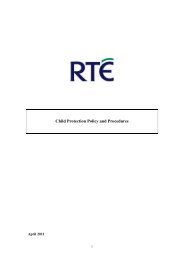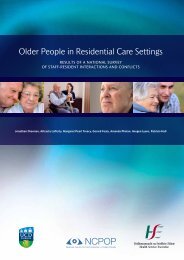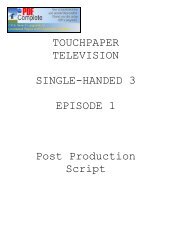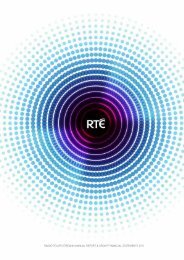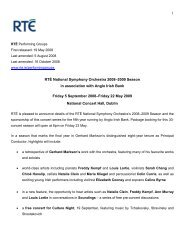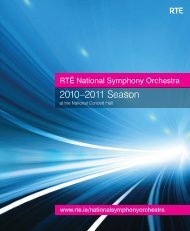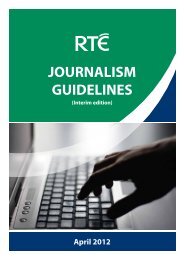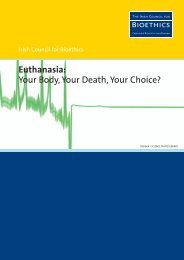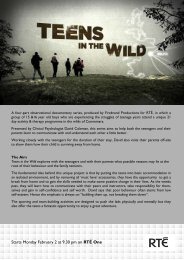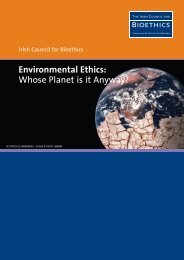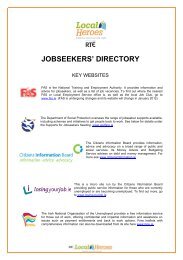Here - RTÃ
Here - RTÃ
Here - RTÃ
Create successful ePaper yourself
Turn your PDF publications into a flip-book with our unique Google optimized e-Paper software.
ANNUAL REPORT & GROUP FINANCIAL STATEMENTS 2008<br />
4. Segment reporting<br />
A segment is a distinguishable component<br />
of the Group that is engaged either in<br />
providing related products or services<br />
(business segment), or in providing products<br />
or services within a particular economic<br />
environment (geographical segment), which<br />
is subject to risks and returns that are<br />
different from those of other segments.<br />
Arising from the Group’s internal<br />
organisation structure and its system of<br />
internal financial reporting, the Group’s<br />
primary reporting segment, under IAS<br />
14 Segment Reporting, is by Integrated<br />
Business Division (IBD). Each IBD is a<br />
separate division organised and managed<br />
separately according to the nature of the<br />
services and products provided.<br />
The Group has only one secondary<br />
(geographical) segment, as it currently<br />
provides its products and services primarily<br />
within one economic environment – Ireland.<br />
5. Foreign currency transactions<br />
Transactions denominated in foreign<br />
currencies are translated to the respective<br />
functional currencies of group entities<br />
at exchange rates at the dates of the<br />
transactions. Monetary assets and liabilities<br />
denominated in foreign currencies at<br />
the reporting date are translated to the<br />
functional currency at the exchange rate<br />
at that date. Any gain or loss arising from<br />
a change in exchange rates subsequent<br />
to the date of the transaction is included<br />
as an exchange gain or loss in the Income<br />
Statement.<br />
Foreign currency differences arising on<br />
retranslation are recognised in the Income<br />
Statement.<br />
6. Property, plant and equipment<br />
(a) Recognition and measurement<br />
Property, plant and equipment is shown<br />
at historical cost, net of accumulated<br />
depreciation and any accumulated<br />
impairment losses.<br />
Cost includes expenditure that is directly<br />
attributable to the acquisition of the asset.<br />
The cost of self-constructed assets includes<br />
the cost of materials and direct labour, any<br />
other costs directly attributable to bringing<br />
the asset to a working condition for its<br />
intended use, and the costs of dismantling<br />
and removing the items and restoring the<br />
site on which they are located. Purchased<br />
software that is integral to the functionality<br />
of the related equipment is capitalised as<br />
part of that equipment.<br />
Subsequent costs are included in an<br />
asset’s carrying amount or recognised as a<br />
separate asset, as appropriate, only when<br />
it is probable that future economic benefits<br />
associated with the item will flow to the<br />
Group and the cost of the replaced item<br />
can be measured reliably. All other repairs<br />
and maintenance costs are charged to<br />
the Income Statement during the financial<br />
period in which they are incurred.<br />
(b) Depreciation<br />
Depreciation is provided on all property,<br />
plant and equipment, except freehold land,<br />
at rates calculated to write off the cost, less<br />
estimated residual value, of each asset on a<br />
straight line basis over its expected useful<br />
life.<br />
The principal rates used are as follows:<br />
Buildings 2.5% – 25%<br />
Plant and equipment 7.5% – 20%<br />
Fixtures and fittings 10% – 25%<br />
Capital projects in progress represent<br />
the cost of purchasing and installing<br />
property, plant and equipment ahead of<br />
their commission into use. Depreciation<br />
is charged on assets from the date of<br />
commissioning.<br />
When parts of an item of property, plant<br />
and equipment have different useful lives,<br />
they are accounted for as separate items<br />
(major components) of property, plant and<br />
equipment and depreciated accordingly.<br />
(c) Impairment<br />
In accordance with IAS 36 Impairment<br />
of assets the carrying amount of items<br />
of buildings and plant and equipment<br />
are reviewed at each balance sheet<br />
date to determine whether there is any<br />
indication of impairment and are subjected<br />
to impairment testing when events or<br />
changes in circumstances indicate that the<br />
carrying values may not be recoverable. If<br />
any such indication exists, then the assets<br />
recoverable amount is estimated.<br />
7. Intangible assets<br />
(a) Recognition and measurement<br />
An intangible asset, which is an identifiable<br />
non-monetary asset without physical<br />
substance, is recognised to the extent<br />
that it is probable that the expected future<br />
economic benefits attributable to the asset<br />
will flow to the Group and that its cost can<br />
be measured reliably. The asset is deemed<br />
to be identifiable when it is separable or<br />
when it arises from contractual or other<br />
legal rights, regardless of whether those<br />
rights are transferable or separable from the<br />
Group or from other rights and obligations.<br />
Intangible assets are carried at cost less<br />
any accumulated amortisation and any<br />
accumulated impairment losses.<br />
The Group’s intangible assets are entirely<br />
software-related in nature.<br />
Subsequent expenditure is capitalised only<br />
when it increases the future economic<br />
benefits embodied in the specific asset to<br />
which it relates.<br />
(b) Amortisation<br />
Intangible assets, with finite useful<br />
economic lives, are amortised to the income<br />
statement on a straight line basis over their<br />
estimated useful lives from the date they are<br />
available for use. In the case of computer<br />
software, the useful economic lives are<br />
generally 3 to 5 years.<br />
(c) Impairment<br />
In accordance with IAS 36 Impairment of<br />
assets the carrying amount of intangible<br />
assets are reviewed at each balance sheet<br />
date to determine whether there is any<br />
indication of impairment and are subjected<br />
to impairment testing when events or<br />
changes in circumstances indicate that<br />
the carrying values are not recoverable. If<br />
any such indication exists, then the assets<br />
recoverable amount is estimated.<br />
8. Financial instruments<br />
(a) Non-derivative financial instruments<br />
Non-derivative financial instruments<br />
comprise investment in subsidiaries, trade<br />
and other receivables, liquid investments,<br />
cash and cash equivalents and trade and<br />
other payables.<br />
Non-derivative financial instruments are<br />
recognised initially at fair value. Subsequent<br />
to initial recognition non-derivative financial<br />
instruments are measured as described below.<br />
Investments in subsidiaries<br />
RTÉ’s investments in subsidiary companies<br />
in its balance sheet are recognised at cost,<br />
less impairment losses.<br />
Trade and other receivables<br />
Trade and other receivables are stated at<br />
cost, which approximates to fair value given<br />
the short-dated nature of these assets. Trade<br />
receivables are carried at original invoice<br />
amount less any impairment for potentially<br />
unrecoverable amounts. Impairment is<br />
recognised if there is objective evidence after<br />
initial recognition that a balance may not be<br />
recoverable in full or in part.<br />
39



